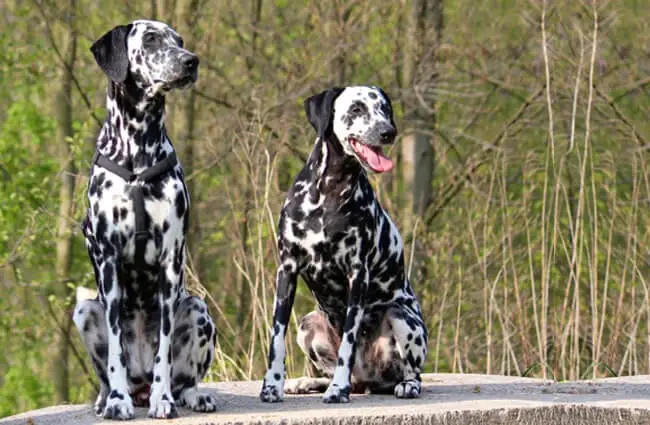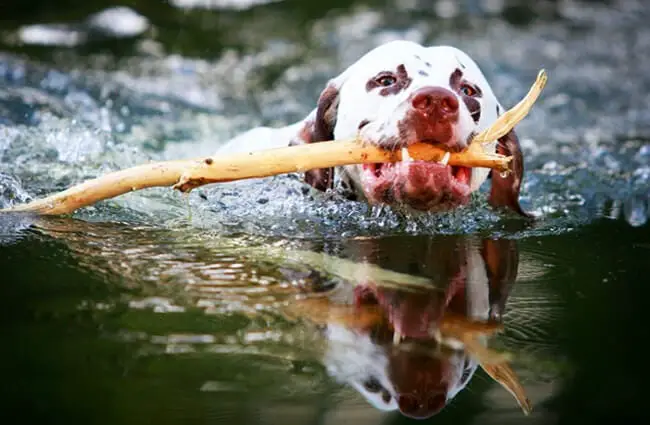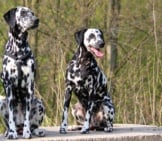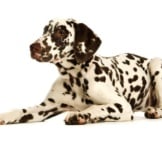The Dalmatian is one of the most distinctive dogs on the planet. Its slim, yet athletic body is famously covered in a beautiful spotted coat. Originally bred to protect horse and human during travel, the dal is still a perennial favorite in many homes. However, their quick spike in popularity after press like the movie “101 Dalmatians” means that some lines are prone to health and behavioral issues. Read on to learn more about the Dalmatian.
Description of the Dalmatian
Bred to be on the road, the Dalmatian is the picture of endurance. These dogs can keep up a steady, light jog for hours. They are medium-large dogs, and their slender frame is highlighted by sleek, short hair. They have gently flopping ears that give them an alert appearance.
Of course, most people associate the Dalmatian with black and white spots. This is the most common coloring, though the spots can also be other colors. Liver, brindle, and blue are some possibilities, while spots may also be nearly nonexistent. Puppies actually develop markings as they age, so young Dalmatians are adorably pale.
The dal was bred as a coach dog. Although their origins are disputed, it is believed that they originated in the Central European region of Dalmatia. They have strong ties to the nomadic Romani people, although they were also used by British elites for their carriages, and even as firefighters.
Life Expectancy and Size
A healthy Dalmatian should live into its teenage years, with a typical life expectancy between 11 and 13 years.
These dogs are lean, but not overly small. After all, they were bred to protect horses. They generally stand between 19 and 24 inches tall, and weigh between 40 and 70 pounds. Bulkier males tend to be the ones weighing in at the top of this spectrum.
Protective Ability
This breed is not thought of as a guard dog. Although they were bred to keep horses, the protective instinct is very faint in many individuals. Any aggression shown by the Dalmatian tends to be due to insufficient socialization, though irresponsible breeding can put some dals at higher risk. Yet, this breed is loyal and dedicated, and more than willing to earn its keep in non-guard-dog duty.
Training
The Dalmatian is alert, but not overly outgoing. With a confident, determined owner, training should not be too difficult. This breed tends to bond strongly with one or two members of the family. With these people in particular, they posses a remarkable desire to please.
To capitalize on this temperament, approach the dal’s learning from a rewards-based perspective. They respond well to verbal praise, and treats can also be helpful in training. However, avoid overfeeding or feeding unhealthy treats like table scraps. This can cause obesity, and lead to many other problems down the line.
This Dalmatian is also a determined breed which, if channeled correctly, can learn quickly. However, it is important to ensure that these dogs have a strong, calm owner to follow. Eliminating distractions during training sessions can also optimize learning.
Energy Level
Because the Dalmatian is not as bubbly as some other high-energy dogs, it can be easy to forget that they need plenty of exercise. This breed was bred to follow a carriage, so they have the capacity for extraordinary endurance. This necessitates extended periods of play and activity.
When these dogs do not get enough exercise, they can become mischievous. Remember this if they begin to bark, chew, or stick their noses in places where they don’t belong!
What Living with a Dalmatian is Like
The Dalmatian is a beautiful dog. There’s no denying that. Unfortunately, a few too many people agree. This breed exploded in popularity, and consequently many irresponsible breeders sold dogs to unsuspecting buyers. Health problems, including deafness, are rampant.
There are many lovely dals out there who are able to bond well with a family. However, it can be hard to determine their temperament. Some are mild-mannered and sensitive, while others can be nervous, or even aggressive. Locating a responsible breeder is the first step, but dedicating ample time for training and socialization is also important.
Many dals can be rambunctious when they are young, when they may scare small or nervous children, so early education is important. Joining family members on hikes or jogs can be a good way to keep this dog busy and out of trouble. As they grow, it is not unusual for this breed to become more reserved. Older, properly socialized Dalmatians are generally good with kids.
Care of the Dalmatian
With proper attention and careful training, the Dalmatian can grow into a steady adult, suitable for a variety of homes and families.
Environmental Needs
The Dalmatian has a short coat, which does not protect very well from the elements. Consequentially, many of these dogs are sensitive to the cold. They can handle extreme temperatures only for short amounts of time. For this reason, they are best suited to relatively temperate climates. Otherwise, it can be difficult to ensure that they receive the exercise they require.
Exercise Needs
This breed requires large amounts of exercise, doing best with families that enjoy incorporating activity in to their daily lives. It’s prime bonding time!
Dals can be good hiking or running companions. Participating in group play can also be fun for them. Playing games like fetch is great exercise, of course, in addition to daily romps.
Some dals can have bone and joint issues that are exacerbated by certain activities. It is especially important to ease them into exercise. When they are very young, start with walks on soft ground, and save jogging and tougher terrain until they are slightly older.
Shedding and Grooming
This breed is low maintenance, but they do shed. This can be particularly frustrating because their hair is so short and white. It sticks to everything!
The Dalmatian requires weekly brushing to remove dry skin and dirt. Short brushes or grooming mitts are good choices. They need only the occasional bath, although their white hair can become stained. It is important to clip the nails regularly to avoid pain and gait changes.
Ideal Home Environment
This breed is best suited for active owners that have a calm, capable demeanor. They can be great family dogs, as long as they are socialized properly.
It is important to understand that it is easier to select for physical characteristics than temperament. Even when precautions are taken, these dogs may be anxious or prone to aggression. Many of the best Dalmatians are still sensitive.
That’s not to say that all or most dals have these behavior issues, rather that there is a greater possibility for them than in some other breeds. Owners should be aware of the variety within the breed.
Health Concerns
This breed is notorious for problems, though the breed as a whole is coming back from years of irresponsible breeding. Many Dalmatians still have some serious health concerns.
Nearly a third of these dogs are deaf or partially deaf. A capable breeder should be able to screen for this issue in their stock. Plus, a partially deaf dog will live a relatively normal life. A completely deaf Dalmatian requires a lot more special care.
Hip problems are also common. It is important to maintain these dogs’ physical fitness without overworking them. Avoid stressing puppies’ bones with jarring exercise.
Finally, this breed is prone to kidney stones. This is particularly problematic in males, whose ureter is smaller. Monitor the Dalmatian’s urination patterns to avoid serious complications.
Behavior Problems
Most behavioral issues are mild, and the result of boredom. Hyperactivity and destructive behavior like chewing or barking are all signs that the Dalmatian has too much energy. Instead of getting angry, take them on more adventures!
As mentioned above, though, Dalmatians may be prone to nervousness that can appear aggressive. Proper, gentle socialization and reward-based training can help build your dog’s confidence and reduce the risk of problematic behaviors.
Youngsters, even after puppyhood, can be rowdy. Starting early, rewards-based training can help channel energy before it becomes a problem. However, know that these dogs tend to calm down with age. As always, if you notice any serious temperamental issues, discuss them with a behavior specialist.
























![Red Angus Closeup of a beautiful Red Angus cowPhoto by: U.S. Department of Agriculture [pubic domain]https://creativecommons.org/licenses/by/2.0/](https://animals.net/wp-content/uploads/2020/03/Red-Angus-4-100x75.jpg)

